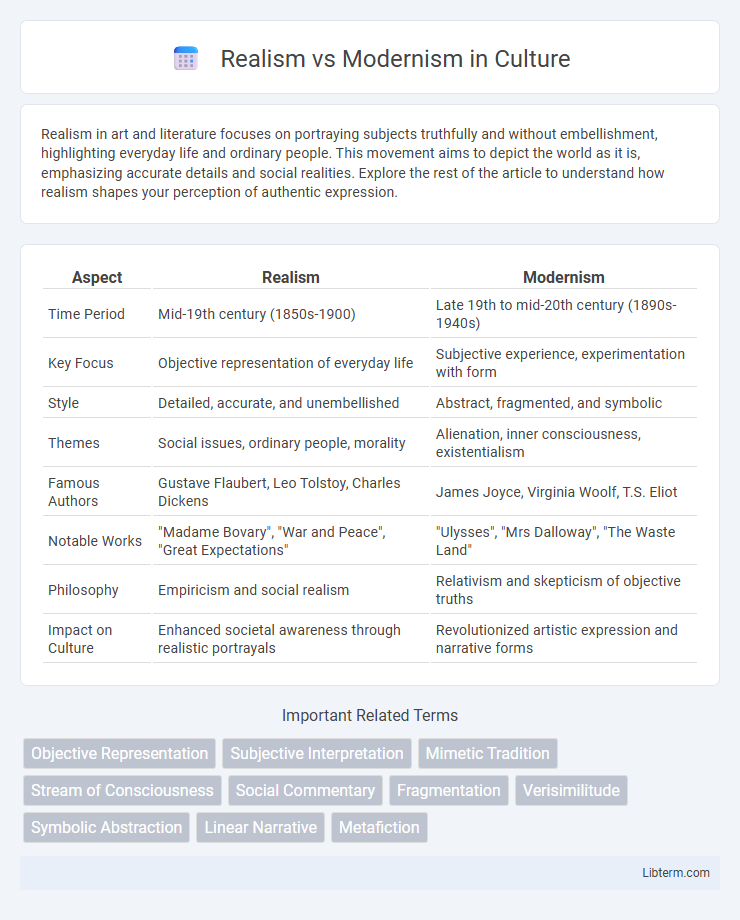Realism in art and literature focuses on portraying subjects truthfully and without embellishment, highlighting everyday life and ordinary people. This movement aims to depict the world as it is, emphasizing accurate details and social realities. Explore the rest of the article to understand how realism shapes your perception of authentic expression.
Table of Comparison
| Aspect | Realism | Modernism |
|---|---|---|
| Time Period | Mid-19th century (1850s-1900) | Late 19th to mid-20th century (1890s-1940s) |
| Key Focus | Objective representation of everyday life | Subjective experience, experimentation with form |
| Style | Detailed, accurate, and unembellished | Abstract, fragmented, and symbolic |
| Themes | Social issues, ordinary people, morality | Alienation, inner consciousness, existentialism |
| Famous Authors | Gustave Flaubert, Leo Tolstoy, Charles Dickens | James Joyce, Virginia Woolf, T.S. Eliot |
| Notable Works | "Madame Bovary", "War and Peace", "Great Expectations" | "Ulysses", "Mrs Dalloway", "The Waste Land" |
| Philosophy | Empiricism and social realism | Relativism and skepticism of objective truths |
| Impact on Culture | Enhanced societal awareness through realistic portrayals | Revolutionized artistic expression and narrative forms |
Introduction to Realism and Modernism
Realism emerged in the mid-19th century as a literary and artistic movement emphasizing accurate, detailed depictions of everyday life and ordinary people, rejecting romanticized ideals. Modernism arose in the late 19th and early 20th centuries, characterized by experimental forms, fragmented narratives, and a focus on subjective experience and inner consciousness. Both movements reflect significant cultural shifts, with Realism addressing societal conditions and Modernism exploring psychological depth and innovation.
Defining Characteristics of Realism
Realism emphasizes accurate, detailed depictions of everyday life, focusing on ordinary characters and social conditions without romanticization or idealization. It prioritizes objective observation and a truthful representation of reality, often highlighting ethical dilemmas and societal issues through complex, relatable protagonists. Key characteristics include a commitment to plausibility, nuanced character development, and settings grounded in real-world environments.
Key Features of Modernism
Modernism emphasizes fragmented narratives, stream-of-consciousness techniques, and a break from traditional linear storytelling, contrasting with Realism's focused depiction of everyday life and social conditions. Key features of Modernism include experimenting with form and style, exploring subjective experiences, and reflecting the complexities of the modern world through symbolism and abstraction. Modernist writers like James Joyce and Virginia Woolf prioritize internal consciousness and psychological depth over external reality.
Historical Contexts: Realism vs Modernism
Realism emerged in the mid-19th century as a response to the social upheavals brought by the Industrial Revolution, emphasizing detailed, truthful depictions of everyday life and the working class. Modernism developed in the early 20th century amid rapid technological advancements and World War I, reflecting fragmented perspectives, experimental forms, and a break from traditional narratives. The historical contexts of Realism center on social reform and objective representation, while Modernism conveys disillusionment and subjective interpretations influenced by global conflicts and urbanization.
Major Authors and Works in Realism
Realism, a literary movement emphasizing accurate representation of everyday life, prominently features authors such as Gustave Flaubert with "Madame Bovary," Leo Tolstoy's "War and Peace," and Henry James's "The Portrait of a Lady." These works underscore detailed character development and social conditions reflective of 19th-century society, contrasting with Modernism's focus on experimental narrative techniques and subjective experience. Realism's commitment to depicting middle-class life and moral dilemmas laid the groundwork for the thematic and stylistic disruptions explored by Modernist writers like James Joyce and Virginia Woolf.
Leading Figures and Texts in Modernism
Modernism in literature is defined by key figures such as James Joyce, whose work "Ulysses" revolutionized narrative techniques with stream of consciousness. Virginia Woolf, another leading modernist, advanced psychological realism through novels like "Mrs Dalloway" and "To the Lighthouse," emphasizing the inner thoughts of characters. T.S. Eliot's poem "The Waste Land" epitomizes modernist experimentation with fragmented structure and allusive language, marking a stark departure from the representational focus of Realism.
Style and Technique Differences
Realism emphasizes detailed, straightforward depictions of everyday life, employing naturalistic techniques and objective observation to portray ordinary experiences without embellishment. Modernism, by contrast, experiments with fragmented narratives, abstract forms, and subjective perspectives, often utilizing stream of consciousness, symbolism, and unconventional structures to challenge traditional representation. These stylistic and technical differences highlight Realism's commitment to accuracy and Modernism's focus on innovation and psychological depth.
Thematic Contrasts in Realism and Modernism
Realism centers on depicting everyday life with accurate detail, emphasizing social issues and the struggles of ordinary people, while Modernism explores fragmented realities, subjective experiences, and existential themes. Realist literature often presents a coherent narrative focused on external realities and social conditions, whereas Modernist works experiment with narrative structure, time, and consciousness, revealing internal conflicts and psychological complexity. Thematic contrasts include Realism's emphasis on objective truth and social critique against Modernism's focus on individual perception, ambiguity, and the breakdown of traditional values.
Influence on Contemporary Literature
Realism's emphasis on everyday experiences and detailed character development has shaped contemporary literature by fostering authentic narratives and relatable protagonists. Modernism's experimental techniques, such as stream of consciousness and fragmented structure, continue to influence novelists seeking to explore subjective realities and complex human psychology. Together, these movements have enriched contemporary literary forms by blending clear social observation with innovative stylistic approaches.
Lasting Legacy: Realism and Modernism Today
Realism continues to influence contemporary literature and art by emphasizing detailed, accurate depictions of everyday life, shaping genres like social novels and documentary photography. Modernism's legacy persists in experimental narrative techniques, abstract art, and a focus on subjective experiences, inspiring avant-garde movements and postmodernism. Both movements collectively expanded creative boundaries, fostering diverse expressions that remain foundational to current artistic and literary innovation.
Realism Infographic

 libterm.com
libterm.com